Rason Special Economic Zone: North Korea as It Could Be
If you have ever been to North Korea, you might know that feeling: you are in the country, and at the same time, you are not. Foreign visitors usually stroll through the streets as if they are caught inside a huge transparent rubber sphere. They can see and hear, but most of the time there is this invisible but tangible wall between them and the world outside. Foreigners manage to break through that barrier only rarely, and if so, only for brief moments.
This is what visitors then speak about with excitement: how they could raise a shy smile from a child, how one of the assigned guides after a long night of drinking finally opened up and provided a glimpse into his personal desires and worries, how they made brief eye contact with a stranger on the street. In the end, this is why most travelers go to North Korea—to look behind the scenes. In addition to the standard images of goose-stepping soldiers on Kim Il Sung square, rising rockets, leaders-looking-at-things, starving children, and nuclear threats, there must be more. But the country does not easily show its real face; xenophobia, nationalist pride and the state’s information policy stand in the way.
My own experience during 23 years of researching and visiting North Korea has not been much different. I can count those few moments, when I did not feel like an isolated odd man out, on the fingers of my hands. But this changed dramatically in September 2014 when I travelled to the Northeast and visited the Special Economic Zone (SEZ) of Rason (formerly referred to as Rajin-Sonbong). To get straight to the point: Rason is simply mind-boggling.
But everything in turn now. Frankly, my expectations were not very high. I had been to the Industrial Zone near Kaesong in the southwest a couple of times. Whatever that is, it certainly has nothing to do with North Korea. Kaesong is a completely artificial world. South Korean factories, guaranteed free of communist propaganda, stand in a previously sparsely inhabited North Korean plain. About 50,000 selected North Korean women are brought in by buses every morning, work their shifts, and then return to their living quarters outside the zone. The area is off limits for ordinary North Koreans and for Western tourists alike. Call it a zoo or Disneyland.
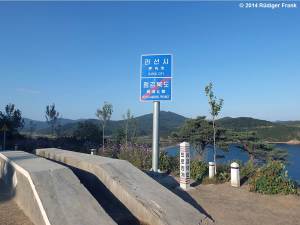
With Rason however… if entering from North Korean territory via Chongjin, there is indeed the feeling of leaving the country. Buses are changed, drivers and guides too. A checkpoint is passed that reminds one strongly of a state border, although passports are only checked, not stamped. The zone is taboo for ordinary North Koreans. A friend told me how he was once able to bring in his Chongjin guides, thanks to the fact that it was his birthday and that he has very, very good contacts within the North Korean leadership. The guides had not been there for ten years although they live less than 80 kilometers away.
At first glance, there is not much to be seen—which, as odd as it may seem, makes Rason fascinating. Contrary to my expectations, it is not just another theme park. Even though Rason has been an SEZ since 1991, and despite travel restrictions for locals, it has remained a part of North Korea that looks, smells, and feels like the original. The roads are a bit bumpy, there are villages with the typical low white buildings, kitchen gardens, surrounding walls, unpaved roads and long wooden chimneys seen everywhere in the DPRK’s Northern provinces. Oxen charts pass by, children with red scarfs march to school, the city is covered with slogans glorifying the “Great Sun of the 21st century, comrade Kim Jong-un” or the Party’s Military First (songun) Policy. Public announcements on wallpapers, like everywhere in the country around this time of the year, remind people that September and October are “hygienic months” (wisaeng wolgan) and encourage them to pay extra attention to cleanliness. A gigantic mosaic mural with the faces of the two deceased leaders sits on a hill, right next to the international telecommunications center that was once built by Loxley of Thailand. Two bronze statues of the leaders are under construction. Many windows in the apartment blocks in Rason are equipped with solar panels, and the balconies are full of red Kimjongilias.[1] It is autumn. Long chains of red pepper dry in the warm September sun and wait to become a key ingredient of Korea’s typical fermented cabbage kimchi.
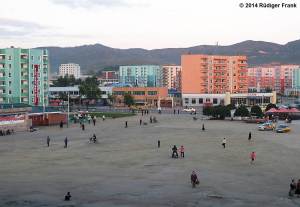
It is North Korea as usual even in our hotel, which was built in the mid-1930s by the Japanese and does not seem to have been renovated too extensively since then. Water is sometimes available, sometimes not. The same is true for electricity; the draught makes the operation of hydroelectric power stations difficult, say our guides. Hot water is provided upon request or twice a day for one hour each. During breakfast, entertainment is delivered on a huge video screen by an infinite loop of the newest performance of the short-skirted Moranbong Band, founded by the new leader in July 2012. With sweet voices and tough words, the band is praising his extraordinary personality and the heroic deeds of the armed forces.
Nothing new on the northeastern front? Not quite. After just five days in “ordinary” North Korea we got used to the fact that taking photos from the bus is deemed, well, not appropriate. Not that this would have prevented us from taking a snapshot once in a while, of course, but admonishment usually followed and made the experience a bit straining. Now in Rason, what is the guide saying? “Take photos as you wish, no problem, you are tourists—isn’t it natural for visitors to do that.” Exactly; this is what I have been preaching to dozens of DPRK guides over the years. But it was like talking to a brick wall. Now that we have official permission to take pictures, it is almost no fun anymore.
Things continue along these lines. In the middle of town, at the central square, stands a huge monitor. Like the one in front of Pyongyang railway station it shows the state TV news and occasionally a movie. In the evening, people sit on the ground and watch. Around them are little stalls selling food and drinks. Photos? Yes, of course. Don’t we also want a beer? Say that again? Go and sit there, right among ordinary people who have neither been briefed nor brought here for a “spontaneous” party with foreigner?
Sure we want to. I somehow expect that our little stall will soon be empty, but no, none of the locals escapes. On the contrary, I see curious looks, and then broad smiles and excited conversation after I tell the waitress in Korean that I have studied one semester at Kim Il Sung University in 1991. I sit among these North Koreans with a strange feeling of happiness, and I think how sad it is that I am so excited about something that would be normal in most other parts of the world.
Without exception, we eat quite well in different profit- and service-oriented restaurants operated as joint ventures with Chinese or Japanese-Koreans. Many such restaurants exist in Pyongyang too. But after lunch, an extended visit to the market—this is something the capital does not offer these days. I visited Pyongyang’s Tongil Market only once, in 2004, and at Chollima speed, for no more than 20 minutes. Here in Rason we get two hours. But as if to remind me that this is still North Korea: no photos please. I know that my explanations about how such pictures will actually improve the country’s image abroad might not be completely lost on the guide, but this will not change the rules that he has to enforce. I obey, grudgingly.
Disappointment quickly makes room for curiosity. At the entrance to the market is a group of women who obviously do not have a license; as soon as they spot a man in uniform, they quickly fold up their wooden boxes with cigarettes and get ready to run. After having passed their espalier, a huge area opens up in front of us, roughly the size of a soccer field, most of it indoors. The lanes of the market are closely packed with women of all ages who sell whatever you can imagine: from fresh fish to refrigerators. In the fruit corner almost anything is on offer: whole pineapples, bananas, nectarines, grapes, and more. The prices are hefty; all these goods are imported from China, as one of the women tells me. One Kilo of bananas costs 14 Chinese Yuan, or Renminbi. I ask for the price of a kilo of bananas in DPRK Won and get an answer only after some hesitation. A secret? No, she simply did not know and had to recalculate, as hardly anybody seems to use the domestic currency here. The Renminbi dominates. But then I get an answer, and my guide even helps me with the calculation—the market rate is about 1:1,300. How is it possible that people here are so frank about a piece of information that is usually hidden from foreigners in other parts of North Korea?
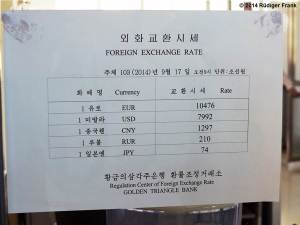
The mystery of this unusual openness gets resolved when I visit the Golden Triangle Bank the next morning. This is a regular bank, right at the main street: a huge building, all glass, steel, and granite. When you ask at any bank or hotel in Pyongyang about the exchange rate of the Euro to the local Won, the answer is usually without hesitation around 1:132. It is such misinformation that lead some of our media to report the nonsense that a small “Orion” choco pie—worth less than 15 cents at Amazon—costs 10 US$ in North Korea.
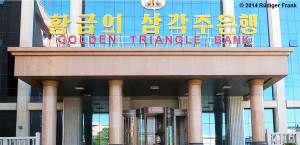
But here I see a list attached to the bank’s wall with the exchange rates of the day: 1 EUR is exchanged against 10,476 Won, 1 US$ is about 8,000 Won, one Renminbi is about 1,300. I must admit my jaw dropped. To make things even better, I can actually exchange Euros into domestic currency at that rate. I am not allowed to take those bills out of the country, but that is of secondary importance. Anywhere else in North Korea the domestic currency is taboo for foreigners, for whatever reason. Here, I can buy it—at a rate now difficult to call “black market rate.”
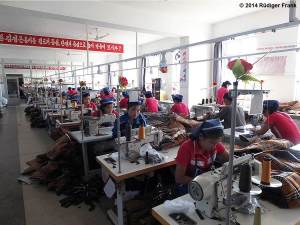
This openness continues. During a visit to a textile factory—again, a regular one, full of propaganda and quite similar to what I saw in the capital—the manager readily answers all my questions, including about the wages of his seamstresses. He pays them 500 Renminbi per month, depending on performance. Try that in Pyongyang—you will get numbers that just make no sense. And while I am still trying to get used to actually receiving real answers to my questions, he asks whether we noticed that the ski suits that are currently produced have a sign saying “made in China” sewn into them. We nod; he explains that this must be done so his client can sell them in South Korea, and shakes his head in a mix of amusement and frustration. Again this pragmatism is nothing new; I have seen suits “Made in Italy” produced in Pyongyang many years ago. What is different is that people in Rason are so open about it.
Our visit continues at the harbor. It has three piers; one leased to the Chinese, one to the Russians, and one left for the DPRK. The Russian pier has been upgraded recently, and huge brand-new cranes stretch into the sky. The Russians have renovated the about 50 kilometers of railway that lead to the harbor; the Chinese have completed a highway to their own territory. Is the history of the late 1950s repeating itself, with China and Russia competing on North Korean soil and Pyongyang pulling the strings?
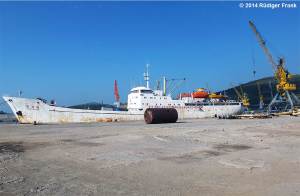
So far, there is little activity. Road and railway are more or less empty, the tracks are rusty. A Russian fisherman from Sakhalin has quickly disappeared into his cabin as he saw our group approaching; he only comes back curiously after I shout a few words in Russian into his direction. Good to speak his native tongue, he says. It is boring here, he complains; nothing to do, no women, no Vodka. He wants to leave as soon as he can, and disappears with a grin.
But if you want to experience true drabness and tristesse, take the 20-minute ride to the Imperial Hotel. Built in 1999 by investors from Hong Kong, this five star hotel is located at a beautiful but deserted beach. Inside we only see Chinese who presumably never leave the building; all they do is sleep, eat, and gamble in the attached Casino.
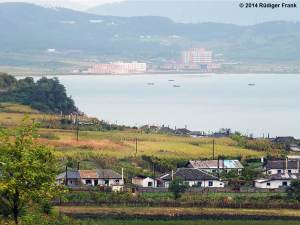
Next to the hotel stretches a decaying hulk of an abandoned project. Five years ago, a Chinese investor bought this top location property at the East Sea beach for 30 US$ per square meter and promised to invest hundreds of millions more. But except a few smaller buildings, not much has happened. The Rason city administration finally lost patience a few weeks ago, paid the fraudster his money back and is now looking for a new, serious investor. I am sure we will soon hear the story of another poor Chinese businessman who was treated “unfairly” by the evil North Korean authorities. I admit: my sympathy for the speculator is limited.
This lack of serious foreign investment is the tragedy of Rason. Here, North Korea is what it could be without major reforms or effort: more open, more human, more approachable, more honest, and obviously very much more interested in business cooperation with the outside world. No insulating rubber sphere anymore for foreigners. The above is not much for us, but a lot by North Korean standards. And isn’t this what we keep asking for all the time? When they have the heart to do it, reduce the restrictions to a minimum, adjust laws and regulations repeatedly to fit the wishes of investors, what happens? Nothing. North Korea opens up and nobody cares.
I leave the Rason SEZ with excitement about what is possible in this isolated country, and full of hope that the reality as I see it in this enclave will sooner or later be extended to the rest of North Korea. After all, Kim Jong Un has announced the opening of 19 new SEZs. But in order for Rason to become a model, it has to overcome the ideological concerns of skeptical cadres. The only way to achieve this is economic success. I feel sorry for the factory manager who gives me the phone number of his sales representative in Yanji so that I can help him with the acquisition of new clients; and I pity our guide who full of pride and enthusiasm lists all the economic projects that have so far been started in the Rason SEZ. I do him the favor and am duly impressed.
However, it is obvious that all that investment into the “Golden Triangle of the Northeast” is mediocre in comparison to even the smallest Chinese city. The reason is clear: serious and well-founded concerns about the security threat posed by North Korea, and about human rights and humanitarian issues. But except for those who still believe in megaphone diplomacy, many observers agree that an economic opening of North Korea would help solve these problems in a more sustainable way, by making the country a stakeholder in peace and international recognition. Nonetheless, it seems that most of the Western world has decided to ignore Rason and rather still waits for an Eastern-Europe-type collapse of the North Korean system—a “strategy” pursued since 1990, with little success so far.
———-
[1] “Kimjongilia” is a special breed of begonia that was named after Kim Jong Il on his 46th birthday.
